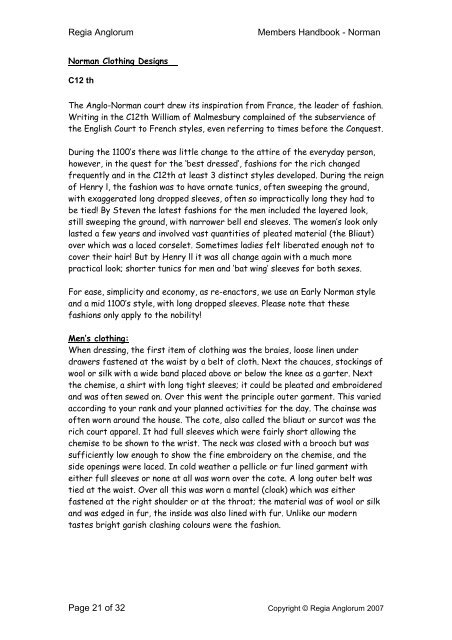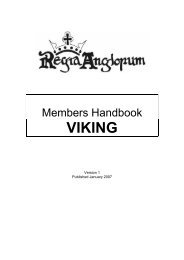Members Handbook - Norman - Regia Anglorum
Members Handbook - Norman - Regia Anglorum
Members Handbook - Norman - Regia Anglorum
Create successful ePaper yourself
Turn your PDF publications into a flip-book with our unique Google optimized e-Paper software.
<strong>Regia</strong> <strong>Anglorum</strong> <strong>Members</strong> <strong>Handbook</strong> - <strong>Norman</strong><br />
<strong>Norman</strong> Clothing Designs<br />
C12 th<br />
The Anglo-<strong>Norman</strong> court drew its inspiration from France, the leader of fashion.<br />
Writing in the C12th William of Malmesbury complained of the subservience of<br />
the English Court to French styles, even referring to times before the Conquest.<br />
During the 1100’s there was little change to the attire of the everyday person,<br />
however, in the quest for the ‘best dressed’, fashions for the rich changed<br />
frequently and in the C12th at least 3 distinct styles developed. During the reign<br />
of Henry l, the fashion was to have ornate tunics, often sweeping the ground,<br />
with exaggerated long dropped sleeves, often so impractically long they had to<br />
be tied! By Steven the latest fashions for the men included the layered look,<br />
still sweeping the ground, with narrower bell end sleeves. The women’s look only<br />
lasted a few years and involved vast quantities of pleated material (the Bliaut)<br />
over which was a laced corselet. Sometimes ladies felt liberated enough not to<br />
cover their hair! But by Henry ll it was all change again with a much more<br />
practical look; shorter tunics for men and ‘bat wing’ sleeves for both sexes.<br />
For ease, simplicity and economy, as re-enactors, we use an Early <strong>Norman</strong> style<br />
and a mid 1100’s style, with long dropped sleeves. Please note that these<br />
fashions only apply to the nobility!<br />
Men’s clothing:<br />
When dressing, the first item of clothing was the braies, loose linen under<br />
drawers fastened at the waist by a belt of cloth. Next the chauces, stockings of<br />
wool or silk with a wide band placed above or below the knee as a garter. Next<br />
the chemise, a shirt with long tight sleeves; it could be pleated and embroidered<br />
and was often sewed on. Over this went the principle outer garment. This varied<br />
according to your rank and your planned activities for the day. The chainse was<br />
often worn around the house. The cote, also called the bliaut or surcot was the<br />
rich court apparel. It had full sleeves which were fairly short allowing the<br />
chemise to be shown to the wrist. The neck was closed with a brooch but was<br />
sufficiently low enough to show the fine embroidery on the chemise, and the<br />
side openings were laced. In cold weather a pellicle or fur lined garment with<br />
either full sleeves or none at all was worn over the cote. A long outer belt was<br />
tied at the waist. Over all this was worn a mantel (cloak) which was either<br />
fastened at the right shoulder or at the throat; the material was of wool or silk<br />
and was edged in fur, the inside was also lined with fur. Unlike our modern<br />
tastes bright garish clashing colours were the fashion.<br />
Page 21 of 32 Copyright © <strong>Regia</strong> <strong>Anglorum</strong> 2007



